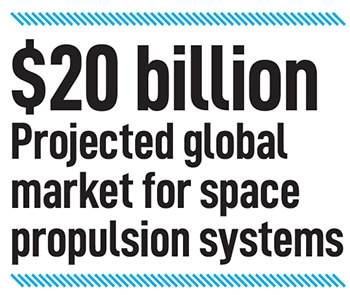Bellatrix Aerospace: Of making in-space thrusters and taxis for satellites
Bellatrix Aerospace is developing cost-efficient in-space thrusters and exploring a space-taxi market for small satellite operators


A recommendation letter from former President of India APJ Abdul Kalam, 10 years ago, set Rohan Ganapathy and Yashas Karanam on their entrepreneurial journey to explore the final frontier.
It had started a few years before that letter, as a college project for Ganapathy. The letter, however, led to a ₹20 lakh seed grant from JSW Steel and helped him and Karanam take the next early steps. Today, their venture Bellatrix Aerospace is on the cusp of commercialising an in-space propulsion engine and a greener rocket fuel alternative.
About the name Bellatrix, “it’s not to be confused with the Harry Potter character", Ganapathy says. The company is named after the star in the constellation Orion. “That’s where we want to head, maybe say 500 years down the line," he says.
Bellatrix Aerospace has developed four classes of engines which can cater to satellites from 10 kg to 5,000 kg. In April, the company sent its first propulsion engine to space onboard an ISRO PSLV rocket, to test and demonstrate its technology.
 This in-space propulsion engine is based on a phenomenon called the Hall effect, discovered by scientist Edwin Hall. The Russians first demonstrated an actual thruster based on the effect, which involves using electrons to ionise an inert gas like xenon inside a container and pushing the ions out at speeds as high as 80 km per second using an electric field. The resulting opposite thrust can propel the engine forward.
This in-space propulsion engine is based on a phenomenon called the Hall effect, discovered by scientist Edwin Hall. The Russians first demonstrated an actual thruster based on the effect, which involves using electrons to ionise an inert gas like xenon inside a container and pushing the ions out at speeds as high as 80 km per second using an electric field. The resulting opposite thrust can propel the engine forward.
“So, we decided to vertically integrate. We set up one of Asia’s biggest space simulation facilities inside the Indian Institute of Science campus," Ganapathy says. “Our indigenisation content is around 84 percent. And what sets us apart is, from the date of order, we can deliver a space-qualified propulsion system in less than four months."
Along the way, several external factors such as India joining the missile technology control regime (MTCR) and locally, the creation of institutions such as IN-SPACe and the liberalisation of space rules to promote private companies have helped the growth of companies such as Bellatrix, Karanam says.
 The duo is also tapping a space taxi opportunity, by building satellites that can take multiple customer payloads, equipped with their in-space thrusters. “Think of it like an Uber pool for space payloads," Ganapathy says. “We are at a place where we’ve completed the development of propulsion systems."
The duo is also tapping a space taxi opportunity, by building satellites that can take multiple customer payloads, equipped with their in-space thrusters. “Think of it like an Uber pool for space payloads," Ganapathy says. “We are at a place where we’ve completed the development of propulsion systems."
The plan is to go from 80 percent R&D and 20 percent commercial activity to 75 percent commercial activity and 25 percent R&D by 2026. They also plan on seeking customers in the US and Europe.
First Published: Oct 12, 2023, 13:25
Subscribe Now